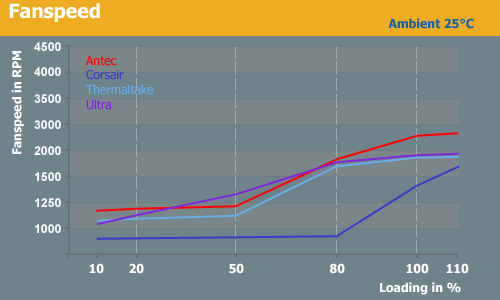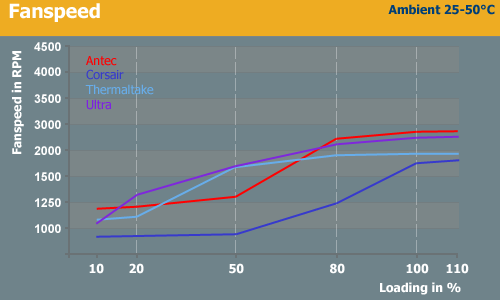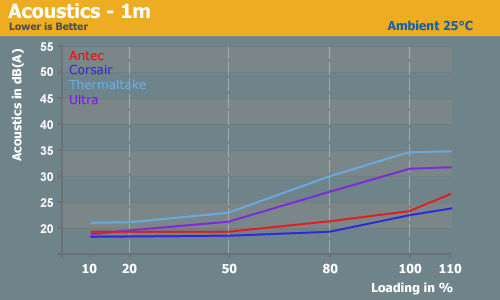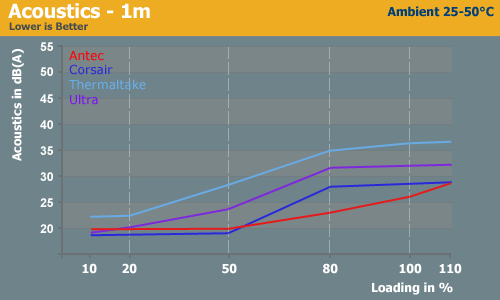400-450W PSU Roundup
by Christoph Katzer on November 6, 2007 4:00 AM EST- Posted in
- Cases/Cooling/PSUs
Comparison
With the four power supplies tested today, we can get a basic idea about the products in the market. Unfortunately, this is a market where higher quality power supplies are getting rare since 500W is the lower end for most companies. A few good manufacturers make 400W and maybe sometimes 350W models, but with many graphics cards "requiring" 500W and higher power supplies marketing has definitely moved to less reasonable units. Rather than creating a good quality 350W power supply, most manufacturers are more interested in attaching a few more cables, adding a couple more components, and selling a 500W (or higher) power supply.
Seasonic is one of the few companies that continue to cater to this market, so it's not too surprising that in addition to their own brand they are also the production facility for the Earthwatts and Corsair power supplies. Staying with Seasonic, however, the M12II series will come out soon and Seasonic wants to start the series at 500W -- just as they did with the first M12 series. That leaves Maxpoint as one of the only remaining companies looking to continue producing lower wattage models.
Despite the marketing hype, many users really have no need for anything beyond a moderate 400W power supply, and perhaps not even that. Consider our results from the GeForce 8800 GT article: with an upper-midrange system, we still topped out at a whopping 327W -- and that's power draw from the wall, not power supply output! Assuming 80% efficiency for the power supply, that particular test system is only using around 260W of power.
As we have seen today, of course, simply going out and grabbing any old 400W power supply might not be a good idea for such a system. While three of the tested power supplies today perform well, we would be very concerned with the prospect of using something like the Ultra 400W. As usual, you get what you pay for. Unfortunately, it seems as though most of the quality power supplies in this range will disappear over the coming year or two, leaving the lower wattage market to cheaper designs that really underperform.
Before we wrap up, let's take a quick look at how the power supplies stack up in a few meaningful areas. We'll start with fan speeds and acoustics.


Corsair clearly has the lowest fan speeds in comparison to the other units. It stays below 1000 RPM until a load of more than 350W is applied. In most actual computers, it will be nearly silent. The other units start to ramp up fan speeds much earlier, which should be not necessary. Corsair keeps the lead even under higher ambient temperatures, despite the fact that the other three power supply fans are spinning 50% faster. Fan speed doesn't really count for noise levels or fan size, however, so let's look at noise measurements.


Comparing the acoustics is interesting because the Antec shows its potential here. The fan turns slightly faster but still produces less noise. Both the Antec and Corsair have a very low noise level and are practically silent. If you're interested in a low wattage, low noise level PSU, Antec and Corsair are definitely worth a look (as well as Seasonic, naturally). The other two power supplies don't do nearly as well. Thermaltake is even louder than the Ultra unit is, even though the fan spins at lower RPMs. Thermaltake should definitely think about changing the fan -- or maybe redesigning the fan grill, heatsinks, or whatever else is necessary -- to bring performance up to the level of Seasonic, et al.
With the four power supplies tested today, we can get a basic idea about the products in the market. Unfortunately, this is a market where higher quality power supplies are getting rare since 500W is the lower end for most companies. A few good manufacturers make 400W and maybe sometimes 350W models, but with many graphics cards "requiring" 500W and higher power supplies marketing has definitely moved to less reasonable units. Rather than creating a good quality 350W power supply, most manufacturers are more interested in attaching a few more cables, adding a couple more components, and selling a 500W (or higher) power supply.
Seasonic is one of the few companies that continue to cater to this market, so it's not too surprising that in addition to their own brand they are also the production facility for the Earthwatts and Corsair power supplies. Staying with Seasonic, however, the M12II series will come out soon and Seasonic wants to start the series at 500W -- just as they did with the first M12 series. That leaves Maxpoint as one of the only remaining companies looking to continue producing lower wattage models.
Despite the marketing hype, many users really have no need for anything beyond a moderate 400W power supply, and perhaps not even that. Consider our results from the GeForce 8800 GT article: with an upper-midrange system, we still topped out at a whopping 327W -- and that's power draw from the wall, not power supply output! Assuming 80% efficiency for the power supply, that particular test system is only using around 260W of power.
As we have seen today, of course, simply going out and grabbing any old 400W power supply might not be a good idea for such a system. While three of the tested power supplies today perform well, we would be very concerned with the prospect of using something like the Ultra 400W. As usual, you get what you pay for. Unfortunately, it seems as though most of the quality power supplies in this range will disappear over the coming year or two, leaving the lower wattage market to cheaper designs that really underperform.
Before we wrap up, let's take a quick look at how the power supplies stack up in a few meaningful areas. We'll start with fan speeds and acoustics.


Corsair clearly has the lowest fan speeds in comparison to the other units. It stays below 1000 RPM until a load of more than 350W is applied. In most actual computers, it will be nearly silent. The other units start to ramp up fan speeds much earlier, which should be not necessary. Corsair keeps the lead even under higher ambient temperatures, despite the fact that the other three power supply fans are spinning 50% faster. Fan speed doesn't really count for noise levels or fan size, however, so let's look at noise measurements.


Comparing the acoustics is interesting because the Antec shows its potential here. The fan turns slightly faster but still produces less noise. Both the Antec and Corsair have a very low noise level and are practically silent. If you're interested in a low wattage, low noise level PSU, Antec and Corsair are definitely worth a look (as well as Seasonic, naturally). The other two power supplies don't do nearly as well. Thermaltake is even louder than the Ultra unit is, even though the fan spins at lower RPMs. Thermaltake should definitely think about changing the fan -- or maybe redesigning the fan grill, heatsinks, or whatever else is necessary -- to bring performance up to the level of Seasonic, et al.










37 Comments
View All Comments
Christoph Katzer - Tuesday, November 6, 2007 - link
Yep, otherwise it's just getting too long and I thought actually nobody is too interested in that analyses anyway. Let me work something out for the next ones...Ripple is also coming today, I updated the 1200-1300 roundup already.
Super Nade - Tuesday, November 6, 2007 - link
Good to know! I understand that it is going to take a considerable amount of work at the outset, to do a bit of design analysis, but once you have the popular topologies employed figured out it should be a lot less work.The length of the review is unimportant if it makes an interesting read. (Hypothetical example) Having 10 pages on the fans employed is going to be be boring. Since you have a wide audience with varying degree of technical appetite, the length of the review should not matter if the content is arranged appropriately.
Best wishes,
S-N
floffe - Tuesday, November 6, 2007 - link
When referring to the 8800GT article, it'd be nice to point out that those 327W from the wall was with SLI. A single card didn't get much over 200W, so even the Ultra should be able to run that, however horrible it otherwise is a a PSU.As for the market, I just wish someone would produce a high quality 300W modular PSU. That'd be plenty for my needs.
xsilver - Tuesday, November 6, 2007 - link
Would you be ok if they charged you the same as a 400w PSU? because for the manufacturers, they're not going to the trouble of making another PSU that costs them almost exactly the same to make.(its like asking for a car with only 15hp because thats all u need ;)
jonnyGURU - Tuesday, November 6, 2007 - link
Exactly. The cost difference at that level is rarely more than a $1. So if it costs me $30 to build a 400W, and $29 to build a 350W, etc. why would I bother?Souka - Wednesday, November 7, 2007 - link
maybe because some people "think" a 350w power supply consumes 50w less than a 400w power supply...:)
Hinkdog - Tuesday, July 21, 2020 - link
My 430 watt Antec Earthwatts that I bought in 2008 just failed. 12 years, pretty cool. Guess the 80mm fan didn't hurt its longevity. I know no one is going to read this in 2020 but wanted to post it anyway.